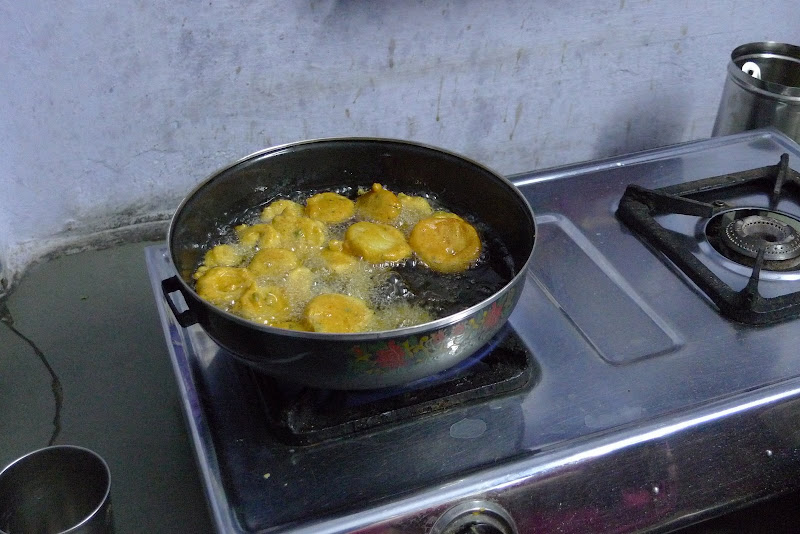
The class, running from 5:30PM until well after 10PM, is run by an interesting woman named Shashi out of her home. Her husband passed away a couple of years back, and she has now managed to turn her cooking lessons into a way to support her family.

We were welcomed in, offered stools to sit on, and handed a printout of the recipes she would be teaching us during the night (she also warned us to make sure we came hungry, which was very good advice). The lesson began much as a coach prepares his players for a big game, talking us through the gameplan for the dinner.

Up first was the traditional Indian tea: chai. It's made by boiling (really rich whole) milk, adding in black tea, and then a delicious combination of cardamon, peppercorns and fresh ginger. As we sat drinking our tea, we began preparing our appetizer: vegetable pakora.
The best way to describe vegetable pakora would be "Indian tempura," as it consists of vegetables coated in chickpea flour and spices and then deep fried. We began with just onions and potatoes, but then made a more interesting concoction of chopped vegetables (cabbage, cauliflower and carrot) mixed with peas, and then fried to a crisp. The pakora were served with two chutneys we made -- one a spicy, cilantro-dominated sauce; the other, a sweet mango one, with hints of chili powder.


We then began preparing the main dishes, starting with a chickpea and tomato masala. Shashi had soaked the chickpeas for about 24 hours to soften them up, and then we just steamed them for about 15 minutes while we prepared the masala. We got to decide how spicy to make it, and since the food actually hasn't been as spicy here as I had expected (I think that even when we ask for things spicy, people see our American faces, and take it easy on us), we were liberal with the chilies. As with a lot of Indian food, there was plenty of oil as we cooked it all up, and then set it aside in a big silver serving bowl covered with a matching plate to keep it warm as we moved on to our next dish.

To accompany the masala, we learned how to make vegetable palau. I finally got something cleared up that had confused me for a while -- both palau and biryani are vegetables with rice, but the palau is more vegetable-dominated, while the biryani skews towards the rice side. This was a fairly simple preparation with cauliflower, cabbage, capsicum (i.e. green pepper), and tomato sauteed with cooked basmati rice. It was soon covered and put aside before we moved on to the main event: bread making.

We made two kinds of bread: naan and chapatti. The naan, to my surprise has a lot of curd and sugar in it, and is based on refined flour, while the chapatti is simply whole-wheat flower, water, and salt. Once the two doughs were made, we formed a nice assembly line where we formed balls of the dough, kneaded it and got rid of any air bubbles, rolled it into a thin pancake, and then cooked them. For the chapatti, in cooking it, one places it on a flat pan, and presses down on it with a towel, while spinning it around to cook it evenly. After a couple of minutes bubbles begin to rise, which you gently push down while twisting the bread around the grill.

We also got to experiment with a couple of other varieties, including a potato-filled bread, where I mashed potatoes with my hands, mixed in chili powder, and incredibly potent lemon salt, forming Indian mashed potatoes. A generous portion is then placed in the middle of the dough, which is folded over the potato as if making a samosa. The mound of potato is then flattened, and painted (repeatedly!) with oil before being grilled.

For our sweet, we had chapati which we coated with ghee (refined butter), confectioner's sugar, and coconut, before folding it in two, and coating it again. And again. And again. And then grilled it up. I played grill-master for a while, which was stressful as there are about six different instruments to use for turning, twisting, lifting, and moving the various breads, and I seemed to always choose the incorrect one. That said, there were no chapatti catastrophes under my watch.
At about 10PM -- after at least four hours in the kitchen -- we sat down to the feast we had created. Everything tasted fantastic, though the highlights were definitely the potato-stuffed, and the sweet-chappatis. The chickpea masala had an intense flavor -- perhaps from sitting covered for a couple of hours -- and made for a great accompaniment to the various breads. Shashi also impressed upon us that by learning the basic sauces, we could then experiment with our own favorite vegetables, substituting them for the ones we used in the pakora, the masala, and the palau.
I came away from the dinner incredibly stuffed, and also with a new appreciation for the cuisine I have been eating for the last six weeks, and will continue to eat for another four! People have asked me if, when I get back, I will want to eat Indian food. My response, though, is that I am officially taking an Indian food hiatus until 2010. But come the new year, if you need a chapatti griller, I'm your man!
The end result:



No comments:
Post a Comment